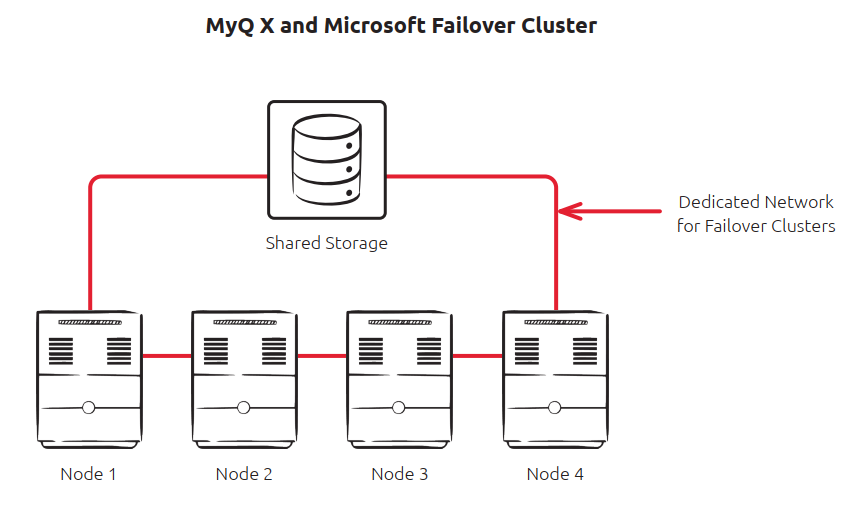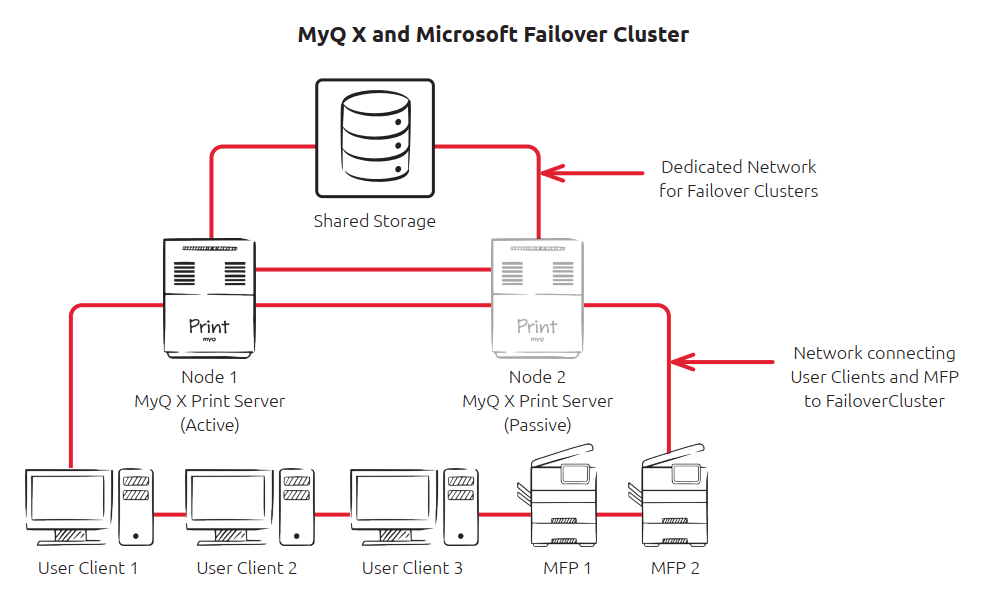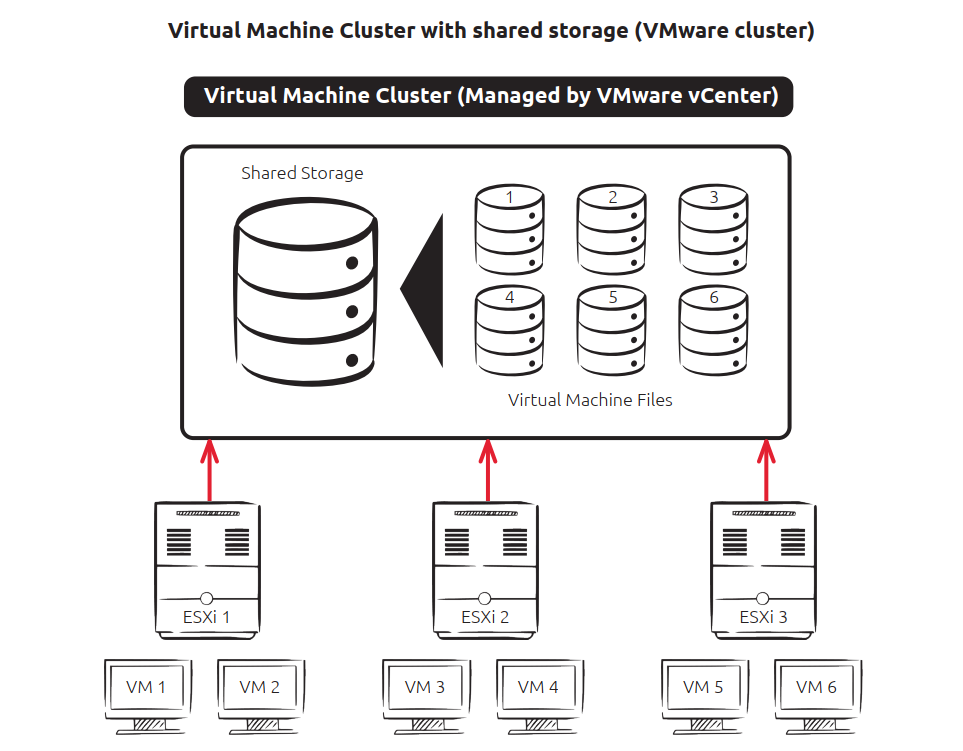Protecting MyQ X with High Availability
High Availability Implementation with MyQ X
Taking into consideration what we have discussed up until now, we will continue to look at different ways of protecting MyQ X with High Availability (HA) technologies, Clustering, and MyQ X’s unique set of failover features.
By this point, you should have a clear overview of your business requirements relating to the Availability of Print and Print management services.
We know that there are many HA methods and technologies available that your organization and IT may already be familiar with and currently use in your existing infrastructure. These HA methods and technologies may deliver similar functionality to that which we will be covering, such as the Microsoft Failover Cluster and VMware’s virtual cluster. In our examples, we will explain the core concept of achieving High Availability with MyQ and your print environment.
If you can achieve the same result with your existing technologies, we recommend that you use what your IT has been trained in and what you are familiar with. When using your own methods and technologies we do, however, recommend that you deploy a proof of concept in a controlled environment and do thorough testing before deploying to a live environment.
At MyQ, we also considered that there might be smaller organizations out there that also require print services to be available during downtime. These organizations do not necessarily have the budget or trained IT staff to deploy expensive and complex HA methods and technologies. Therefore, we have developed a set of MyQ X failover features that are free to all MyQ X customers. These features were designed to keep our customers printing during planned or unplanned server downtime.
Microsoft Failover Clustering
Microsoft Failover Cluster is a Windows Server (Operating System) based feature. The software solution facilitates the grouping of multiple independent hardware servers (hereafter referred to as nodes) into a cluster. The nodes in the cluster collectively work together to provide advanced capabilities such as resource management, health monitoring, and failover coordination.
In terms of storage requirements for high-availability implementations, it is recommended that there should be at least one shared storage location that is accessible to all nodes in the cluster. The interconnected nodes within the cluster should be configured to access the shared storage via, for example, a high-speed network connection.
The interconnected communication between the multiple nodes combined with shared storage makes this solution highly available. If one of the clustered servers (nodes) fails, the other nodes will take over to provide service (the failover process). The clustered nodes are proactively monitored. When the software detects that a node is not working correctly, they are automatically restarted or moved to another node.

Microsoft Failover Cluster Illustration
MyQ X and Microsoft Failover Clustering
The MyQ X and Microsoft Cluster high availability concept consists of grouping at least 2 nodes into a failover cluster. The failover cluster will be managed using Microsoft’s Windows Server failover cluster functionality and should be configured for shared resource management, health monitoring, and failover connection.
The nodes within the failover cluster must be configured to include a high-speed network-attached to shared storage that is accessible by all the interconnected nodes within the failover. MyQ X is then deployed within the cluster in an active-passive configuration with the MyQ X Print server installed on at least 2 nodes. Microsoft’s failover cluster software administrates the MyQ services, if the currently active node becomes unavailable, it switches to one of the available passive nodes.
The benefit of deploying MyQ X within the Microsoft failover cluster is that the system is no longer dependent on only one physical hardware server and is, therefore, more resilient toward hardware failures.
Read more…
Continue to our Manual on MyQ and MS Cluster for the exact configuration details. You will learn how to set up MS Cluster and prepare MyQ for running in this setup.
📓 Example:
In the illustration below, the MyQ X Print Server is deployed in an active-passive configuration within the Microsoft failover cluster, with Node 1 set as active and Node 2 set as passive. Node 1, Node 2, and the shared storage are interconnected over a dedicated high-speed network. In addition, this configuration also requires a separate network that interconnects the user clients and multifunctional printers with Node 1 and Node 2. The separated networks are based on the high availability concept to eliminate single points of failure.
Microsoft’s failover cluster software administrates the MyQ services and continuously monitors the health of the nodes. If it detects that the active node (Node 1) becomes unavailable it will try and recover the services, if it is unable to recover the services it automatically switches to the passive node (Node 2).

MyQ X deployed in Microsoft Failover Cluster
Virtual Machine Clustering (VMware Cluster)
The primary purpose of Virtual Machine (VM) clustering is to run services in a virtualized environment, ensuring high availability and enhanced server utilization. Hardware failures within a virtual machine cluster have minimal impact on virtual machines as the VM will transfer to another node.
A Virtual Machine cluster typically consists of several components. You will need hypervisor technology, for example, VMware’s vSphere ESXi. The vSphere ESXi image is installed on bare-metal hardware just like an OS and acts as a Type 1 hypervisor (referred to as an ESXi host). The ESXi hosts are configured so that their resources are shared.
An essential component of configuring a High Availability Virtual Machine cluster is to choose an adequate storage solution that is highly resistant to faults with no single points of failure. MyQ recommends combining your Virtual Machine cluster with a network-attached shared storage solution. However, different Virtual Machine clustering software providers deal with cluster storage in various ways and there may be other storage solutions that better fit your organization. The general concept of eliminating single points of failure should remain, the storage solution that you choose should meet your individual business requirements in terms of operational uptime and cost.
ESXi hosts can be managed using a centralized server management platform like VMWare vCenter. vCenter allows for central management of the underlying compute resources of the ESXi hosts and administration of Virtual Machines, including a host of features such as VM Cloning, High Availability, Fault Tolerance etc. In addition, using vCenter, you can group several ESXi hosts to create a Virtual Machine cluster. Each Virtual Machine in a cluster is interconnected via a virtual network.

Example of a Virtual Machine cluster using VMware technologies
MyQ X and Virtual Machine Clustering (VMHA)
The MyQ X Virtual Machine clustering concept also referred to as VMHA (Virtual Machine High Availability) consists of running the MyQ X system in a virtualized cluster environment in combination with NAS (network-attached storage) datastore.
The NAS (network-attached storage) consists of external storage systems which the server nodes (ESXi hosts) will use to store and access Virtual Machine files remotely. The ESXi hosts will access these systems over a high-speed storage network. The datastores on networked storage can be accessed by multiple server nodes (ESXi hosts) concurrently. The MyQ X print server is installed on a virtual server node (ESXi host), with the workload and resources of the virtual node distributed across the virtual cluster. When utilizing MyQ X’s integrated system database (Firebird database) the data will be stored on the virtual instance. With this concept, data is always available whenever the MyQ X virtual instance is moved to other nodes within the virtual cluster. In addition to database data, print job data is stored within the jobs folder on the MyQ X virtual instance.
The benefit of deploying MyQ X with the VMHA mode in a virtual cluster is that the system is no longer dependent on only one physical hardware server and is, therefore, more resilient toward hardware failures. VMHA can also operate in a private cloud environment like, e.g., MS Azure, with the prerequisite that there are established VPN (Virtual Private Network) tunnels between the MyQ X server and the organization’s local network.
📓 Example:
In the illustration below, the MyQ X Print Server is deployed on VM 1 which is assigned to ESXi Host 1. The Virtual Machine image of VM 1 is stored securely in the shared storage location, the shared storage can for example be a NAS (network-attached storage). If ESXi Host 1 fails, VM 1 (MyQ X Print Server) will move for example to ESXi Host 3 and continue working uninterrupted. The MyQ X Print Sever data and print job remain secure in the datastore and unaffected by hardware failure.

Virtual machine cluster failover operation
.png)